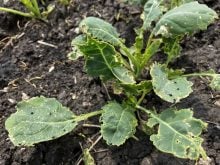Trees can be a pain to farm around, but they put more money on the bottom line and reduce extreme weather threats
Removing shelter belts to accommodate today’s larger farm equipment is a common practice that could hurt farmers in the long run.
Prairie researchers are examining both the environmental and economic roles of shelter belts as many of the plantings near the end of their lifespan or farmers rip them out.
Research has already shown that while there are immediate yield losses next to the trees, there are yield increases further out that outweigh those losses.
There is also preliminary data to suggest increased canola oil content in sheltered areas.
Read Also

Growing garlic by the thousands in Manitoba
Grower holds a planting party day every fall as a crowd gathers to help put 28,000 plants, and sometimes more, into theground
Shathi Akhter, a research scientist at Agriculture Canada’s research centre in Indian Head, Sask., said the yield numbers depend on the heights of the trees.
Losses occur out to about 1.5 times the height of a shelter belt, but then gains occur to at least 10 times and up to 20 times the height.
“If you have a shelter belt of 40 feet high, you will lose some yield, up to 60 feet,” she told an organic and low-input field day in Swift Current.
“However, you will gain yield probably up to 500 feet.”
This is because of the microclimate the shelter belt creates.
Akhter said shelter belts mitigate the effects of drought by catching snow and offering wind protection. They also moderate temperature: afternoon temperatures will be lower in the microclimate than in the middle of an open field.
The summers of 2017 and 2018 have offered lots of heat and wind, she added, and trees will become more important if weather patterns continue to change.
She said researchers at the centre in Indian Head could help farmers decide what type of trees would be best to plant to get maximum yield.
There is only one year of data that shows increased canola oil content, and Akhter said she would like two to four more years of data to be confident in the assessment. However, if this does prove true, she said it would boost the canola economy.
The trees do cost money.
Akhter said a one-acre shelter belt with a 25 to 30 year lifespan costs about $56 per year.
“But if you can increase yield by 10 to 12 percent on the 15 acres that the shelter belt affects, actually you’re still on a net benefit of over $200,” she said of canola in particular.
She used an average yield of 36 bushels per acre in her calculation, and 54 bu. yields in the sheltered areas.
Aside from moisture and protection, trees provide numerous environmental benefits.
“We are trying to see how the number of pollinators that we are finding in shelter belt areas compares to (the number in) open fields,” she said.
There are also ground beetles that feed on harmful pests.
“At which point are we going to see that having those beneficial ground beetles is going to be efficient enough to not apply pesticide?” Akhter said.
In the Indian Head area, she is collecting data from three canola fields in each of five different soil types. One field has an established shelter belt at least 15 years old, another has a natural boundary habitat or wetland and the third has no habitat at all.
She wants to determine the yield and presence of pollinators at different distances from the shelter belts.
Again, only one year of data is available.
However, Akhter said even hybrid canola varieties produce more pods and have a better seed weight when pollinators are in the field.
Another research project she wants to do would use drone and satellite data to calculate the total length of prairie shelter belts and quantify the impacts of all of those trees. She said producers have to be convinced not to pull out any more, even though she recognizes they are farming in an era of huge equipment that makes it difficult to farm around them.
“It breaks my heart every time I drive by and see another pile of pulled trees,” she said.
As well, she worries that as farmers have to cope with more drought cycles and extreme heat they will be wishing they had the trees they had pulled.
“It’s easy to lose them, but it’s very hard to build them,” she said.


















